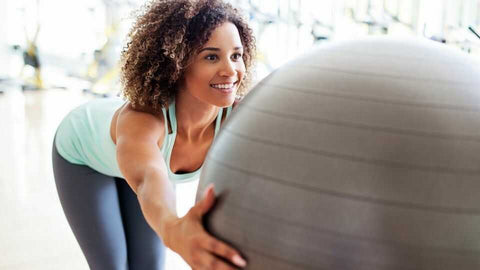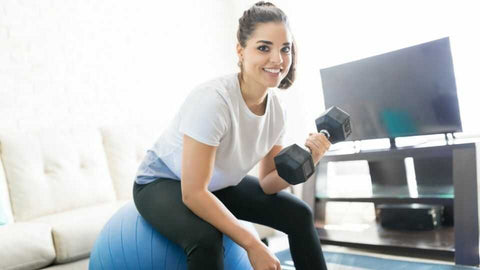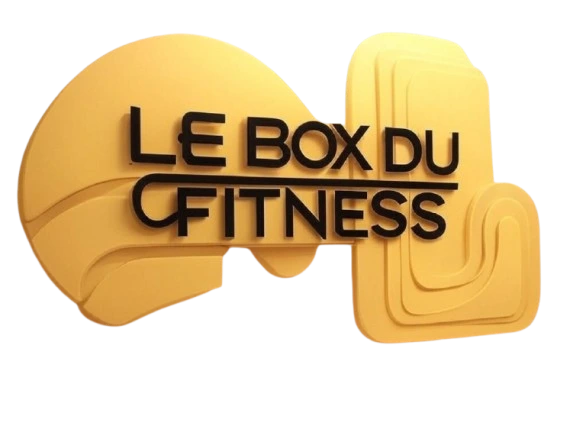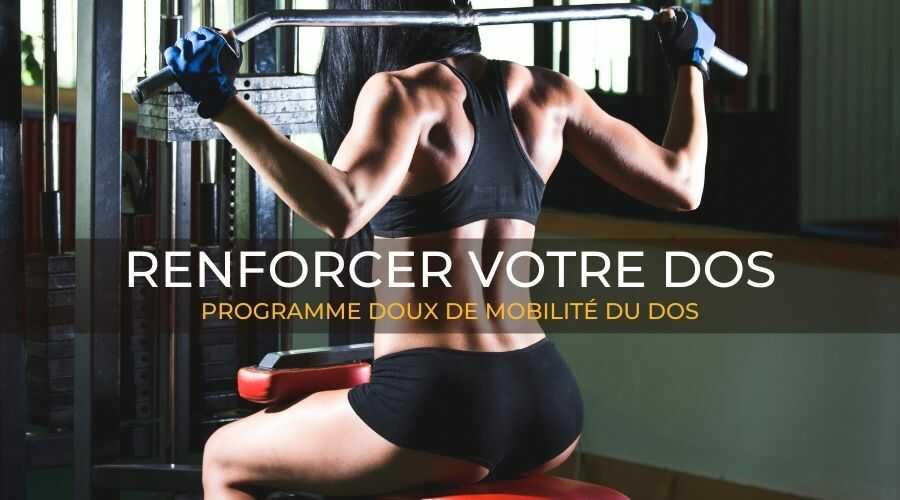Is the Swiss Ball good for your back?
Using an exercise ball to rehabilitate your back.
Lower back injuries often limit movement and can lead to weakening of the lower back muscles.
Exercise balls are a great option for a gentle back mobility and core strengthening program that can stabilize the muscles surrounding your spine, improve movement, and help prevent future injuries.
Exercises with an exercise ball can strengthen and mobilize your spine.
An exercise ball works on your stability.
When you sit on this ball or use it to exercise, the muscles that stabilize your spine are activated to prevent you from falling or losing your balance.
These muscles generally include the superficial and deep groups that surround and support your spine.
Activating your spinal muscles can help strengthen and tone muscle fibers, improving pain, stiffness, weakness, and function in your back.
1. Develop your core strength
Core strength refers to the body's ability to position and move the torso and control the transmission of forces between the upper and lower extremities.
A workout with an exercise ball helps activate the muscular and nervous mechanisms of your abdomen and back.
An exercise ball session helps activate the muscular and nervous mechanisms of the abdomen and back, which reduces stiffness and fatigue and improves the strength of these muscle groups.

You can strengthen your core by performing the exercise ball plank:
-
Place your forearms and elbows on top of the ball, feet on the floor.
-
Your trunk and legs should be elevated and straight.
-
While holding this position, squeeze or contract your abs and lower back to activate your core muscles.
-
Make sure your posture is correct: A straight line should be established from your shoulders to your ankles through your hips.
You can perform this exercise for a set amount of time, depending on your tolerance, and gradually increase the duration as you progress.
Start with 3 sets of 25 seconds and work up to 1 minute in 10-15 second increments, depending on your tolerance.
2. Improve your spinal endurance
Stiffness in the muscles that support your spine can reduce the stability of your spinal joints, which can cause your spine to deform under heavy loads.
Spinal stiffness in the core muscles and associated spinal joints can also significantly limit spinal mobility.
Exercise ball exercises help relieve muscle stiffness and improve spinal strength and endurance, which prevents the spine from giving way when subjected to sudden movements or stresses.
3. Spinal rotation with exercise ball
Gently improve your spinal mobility and endurance using an exercise ball in a simple spinal rotation exercise:
-
Lie on your back and place your calves and feet on the ball.
-
While using your core muscles and legs to control the ball, rotate the ball from side to side through a range of motion that you can successfully maintain.
-
Perform 3 sets of 30 to 45 seconds of this activity.
4. Increase the flexibility of your spine
When you have better core strength and spinal endurance, your spinal flexibility is increased, allowing you to bend forward and backward more efficiently and with less pain.
Maintaining flexibility in the many muscles of the core is also essential to maintaining multidirectional movement of the spine.
Modified Child's Pose with an exercise ball.
Here's a stretch that involves using an exercise ball to improve spinal flexibility by modifying the commonly used Child's Pose:
-
Kneel with the ball in front of you and one forearm on the ball (e.g. the right) while tucking the opposite (left) arm under the torso.
-
Slowly sit back on your heels, while your forearm on the ball (right) extends diagonally forward and bends your torso slightly to the side, while your other arm (left) continues to pass under your torso.
This exercise stretches several muscles, especially the latissimus dorsi and quadratus lumborum on the same side, both of which are core muscles that are often tight or stiff.
Perform this stretch 3 times per side, holding for 30 seconds each repetition.

5. Improve your balance and posture
Core strength is important for maintaining balance while standing, sitting, and walking.
Exercising with an exercise ball can help improve muscle strength and coordination in this area to increase balance, correct posture, improve gait, and reduce the risk of falling.4,5
Sit on an exercise ball for 30 minutes.
Simply sitting on an exercise ball can help improve your posture and balance.
This requires subtle, but constant, engagement of your core muscles to stay balanced and centered on the ball.
When using an exercise ball for the first time, place your feet flat on the floor and simply sit on the ball for about 30 minutes.
Beginners may find it easier to balance on a slightly deflated exercise ball.
Make exercise ball exercises part of your daily routine .
One of the easiest ways to incorporate an exercise ball exercise into your routine is to practice sitting on it. Sitting on the ball activates the core muscles needed to maintain balance.
If you have trouble keeping your balance, deflate the ball a little for more stability. If your balance is good, try replacing your office chair with an exercise ball or sitting on the ball while watching TV.
Stand up straight with your head and chest up, your spine straight, while keeping your shoulders pulled back and slightly lowered (by drawing your shoulder blades together).
Once you feel comfortable on the ball, you can try more advanced exercises, like wall squats with the exercise ball, or some of the exercises mentioned previously.
As with any exercise program, it is essential to consult your physician or licensed physical therapist before beginning training.
Many exercise balls come with their own set of exercises, attempting an advanced move before you are ready can lead to injury.
A qualified professional can provide you with a list of exercises tailored to your specific needs and show you how to properly use the exercise ball.
Do Exercise Balls Help With Back Pain?
The exercise ball is an exercise treatment option for people with back pain.
It is designed to help prevent or minimize new episodes of low back pain as part of a rehabilitation program.
The exercise ball is effective for back rehabilitation because it strengthens and develops the core muscles that help stabilize the spine.
With the exercise ball, also called a Swiss ball or physio ball, an element of instability is introduced into the exercise, which is not normally the case with a floor exercise.
The body naturally and automatically responds to this instability to stay balanced on the exercise ball. Over time, the muscles used to stay balanced on the exercise ball become stronger.
By working with a gym ball, individuals strengthen important back and abdominal muscles without knowing it.
The exercise ball also uses what is called "proprioception", which is the awareness of the position of the hand or foot in relation to space.
The instability of the exercise ball provides the body with constant opportunities to assess its orientation in space, developing and training the body's natural awareness.
Improved proprioception provides the body with increased balance and stability.
Additionally, it is thought that the type of spinal movement induced by exercise ball use (small range of motion, balance adjustment) may help reduce pain by stimulating the body to produce increased amounts of natural pain inhibitors.
The benefits of exercising on an exercise ball for people with lower back pain include:
A simple and versatile way to get moving again after a bout of back pain.
Here are the benefits of an exercise ball for lower back pain:
-
Improved muscle strength
-
Greater flexibility and range of motion of the spine
-
Improved balance and coordination of core muscle groups used to stabilize the spine and control good posture when using the exercise ball, reducing stress on the lower back.
-
A greater tendency to maintain a neutral spinal position during exercise.
In particular, many Swiss ball exercises are designed to bring movement to the spine in a controlled manner to help nourish the discs.
Movement of the vertebrae helps nourish the discs in the spine by increasing blood flow around the disc and moving water in and out of the disc.
The exercise ball has other applications in areas such as general fitness, strength training or weight training, as well as exercise for pregnant women.
For all forms of exercise, it is advisable to consult a properly trained and licensed spinal specialist.
You may want to see a physical therapist, occupational therapist, chiropractor, exercise physiologist, or physical medicine and rehabilitation physician (also called a physiatrist).
Depending on the specific diagnosis and pain level, the exercises with the ball will differ.
Properly trained spine specialists (e.g., certified in exercise ball technique) play a critical role in developing the appropriate exercise program and teaching correct form and technique. 
About Exercise Balls
The term "Swiss ball" was coined because one of the first known uses of an exercise ball was in Switzerland in 1965.
A group of physiotherapists used it in their work with children with cerebral palsy.
The exercise ball can also be called:
-
Gym ball or gymnastics ball.
-
Stability ball
-
Therapy ball
-
Physio ball
-
Blue balloon (because many are blue).
Exercise balls vary in size.
Physical therapists and trainers suggest using an exercise ball that is appropriate for each person's height and leg length.
Hips and knees at a 90-degree angle or slightly greater (thighs parallel to the floor or pointing slightly downward), with feet flat on the floor.
Before using or purchasing an exercise ball, it is best to consult with a physical therapist, exercise physiologist, or other spinal specialist to obtain a proper fit.
The exercise ball can be inflatable, made of vinyl or plastic or solid foam rubber.
Inflatable exercise balls can be punctured, so it's best to avoid wearing sharp objects (like jewelry or a belt buckle) while using the ball.
Plastic exercise balls can be damaged by exposure to heat or excessive sunlight. Some manufacturers claim designs that prevent the exercise ball from exploding if punctured, allowing air to slowly escape.
One of the factors in choosing an exercise ball is its durability and ability to retain its shape under pressure.
Manufacturers must provide the retailer with test load figures indicating how much weight the exercise ball can support.
Inflatable exercise balls may be sold deflated, requiring an air pump to fill them. Often, a pump can be purchased with the exercise ball.
Manufacturer's instructions regarding air pressure and fill levels should be followed.
One of the benefits that many people enjoy about the exercise ball over other types of exercise equipment is that it is portable.
When traveling, you can place a deflated balloon in a suitcase and inflate it upon arrival (using your own lungs or a small hand pump).
Uses of the Exercise Ball
The many applications of the exercise ball follow a range of difficulty levels, and the benefits for back pain patients can be felt at each level.
Whether simply sitting on the exercise ball or doing structured aerobic exercises, the basic support your back and stomach muscles need is the same.
When it comes to lower back pain, the exercise ball can be used for a variety of purposes, including:
-
Find a neutral spine position.
-
Learn good posture
-
Increase lumbar (lower back) mobility
-
Increase abdominal and back muscle strength
-
Improve balance and stability
-
Develop control and strength of the core muscles of the body.
-
Learn how to lift properly

Getting Started with an Exercise Ball
To get started with ball exercise, it is often recommended to sit on the ball for 30 minutes a day and bounce gently, continually finding and maintaining balance on the ball.
Another recommended first step on the exercise ball is to find a neutral (lordotic) position of the lumbar spine.
-
Lean slightly over the exercise ball, rounding your lower and upper back.
-
Begin bouncing lightly on the exercise ball.
-
Allow the body to automatically find the upright position, which helps maintain balance while continuing to bounce on the exercise ball.
This balanced position on the exercise ball is also called the center of gravity, where the upper body is balanced on a stable pelvic base.
Even a slight change in this neutral position will shift the center of gravity and require correction to stay on the exercise ball.
The stomach muscles must work constantly to maintain this neutral and balanced position.
Everyday Uses of the Exercise Ball.
Lifting objects is a common cause of lower back pain and muscle strain.
Certain exercises with the exercise ball can be helpful in teaching proper body mechanics and posture when lifting.
-
Ergonomic lifting
-
Place the exercise ball against a wall at lower back level, with your feet shoulder-width apart and 1 to 2 feet in front of your hips.
-
With your hands on your hips and your knees slightly bent, squat halfway down without leaning on the exercise ball, but letting the ball guide your back position. Your knees should not go beyond your toes.
-
Return to standing position. Repeat 5 times.
-
Increase the difficulty by holding the squat for 10 seconds.
This exercise is a good move to practice with a spine specialist (such as a physical or occupational therapist) who can provide guidance in identifying the correct position to use for lifting.
Sit on an exercise ball.
The exercise ball can also be used to replace a chair at work or at home.
The movement of the exercise ball requires a muscular response to maintain the center of gravity and balance on the ball.
This stimulates the deep core muscles (multifidus and transverse abdominis) which play an important role in supporting the spine, and reduces the static load on a single structure of the spine.
Exercise ball for support during pregnancy.
For pregnant women, exercise balls can help exercise while supporting the extra weight and shift in center of gravity caused by pregnancy.
During labor, the exercise ball can also be used to support certain positions, perform rhythmic movements, bounce gently, etc.
Exercise ball workouts commonly prescribed for back pain.
The exercise ball (or stability ball or physio ball) is a versatile piece of exercise equipment designed to help people with back pain.
In particular, many exercise ball programs are designed to bring movement to the spine in a controlled manner to help nourish the discs.
Moving the vertebrae helps nourish the discs in the spine by increasing blood flow around the disc and moving water in and out of the disc.
Additionally, your local gym or fitness center is often a good place to find someone certified in exercise ball technique.
The difficulty of exercises using an exercise ball varies from person to person and challenges areas of inflexibility.
Typically, a physical therapist or other spine specialist will have the patient begin using an exercise ball by performing small, gentle movements, such as the following:
Pelvic isolation with the exercise ball.
Toggle back and forth:
-
Sit on the exercise ball with your arms at your sides or on your hips.
-
Slowly perform a pelvic tilt, pulling in your stomach muscles and moving your hips slightly forward to flatten your lower back (reduce lordosis).
-
Return to neutral position on the exercise ball.
-
Arch your lower back slightly and move your hips back slightly.
-
Return to neutral position on the exercise ball.
When you feel comfortable with these movements on the exercise ball, do them continuously back and forth for 10 repetitions.

Tilt from side to side:
-
Sit on the exercise ball with your arms at your sides or on your hips.
-
Slowly shift your weight slightly to the right.
-
Return to neutral position. Slowly shift your weight to the left.
-
Return to neutral position on the exercise ball.
When you are comfortable with these movements, do them continuously from side to side for 10 repetitions.
Circles:
For a more advanced exercise, start in the front/pelvic tilt position and slowly move the weight in a circular motion, 3 times clockwise and 3 times counterclockwise.
Spinal Rotation with Exercise Balls:
- Sitting on the exercise ball, raise your arms forward; without twisting your spine, move both arms to the right, bending your left elbow and keeping your arms at shoulder height; move both arms to the left, bending your right elbow.
Repeat 5 times on each side.
- Add the head movement to the arm movement by rotating the head in the opposite direction to the arm movement, again without twisting the spine. Repeat 5 times on each side.
- Increase the difficulty by spreading your feet slightly apart and rotating your spine in the direction of the arm movement, straightening the opposite knee and rocking slightly forward onto the ball if necessary.
Mobility and stretching with the exercise ball:
-
Sitting on the exercise ball with your arms at your sides, slowly spread your feet apart and lean back slightly, rolling the ball towards your upper back.
-
Raise your arms overhead and straighten your knees to arch over the ball, moving it toward the middle of your spine and touching the floor with your hands.
-
Hold the stretch for 10 seconds before bending your knees, bringing your arms down and rolling the ball back to the starting position. Repeat 3 times.
-
Kneel with hands on the exercise ball; use hands to roll the exercise ball outward from the body, keeping the back flat until the hips and knees are at 90 degrees and the back, head, and arms are straight
-
Roll the exercise ball lightly from side to side, 5 times on each side.
-
Kneel with your chest resting on the exercise ball; roll forward and straighten your knees, with the ball at chest level, relax around the ball to stretch your upper spine.
Extension exercises:
Lumbar extension
-
Place lower chest/stomach on exercise ball with legs straight, spread apart for stability and feet flexed over toes (or legs together and feet against a wall)
-
Place your hands on the side of the ball, but do not use your arms to lift yourself up
-
Slowly lift your head and chest off the ball as far as you can, squeezing your shoulder blades together as you lift.
-
return to the starting position.
Repeat the exercise 5 times.
For a more challenging exercise, place your hands behind your head or extend your arms overhead.
Bridge :
-
Lie flat on the floor with your legs straight.
-
Place both legs together on the exercise ball at calf level, arms at your sides and hands flat on the floor
-
Squeeze and lift your buttocks off the floor to straighten your back, keeping your abdominal muscles tight and hold for 5 seconds.
-
Return to the starting position.
Repeat 3 to 5 times.
Leg Bridge : Make this exercise more challenging by lifting one leg at a time 1 to 2 inches off the Swiss ball.
Arm Bridge : Even more challenging, raise your arms off the floor while bridging over the exercise ball.
There are hundreds of different exercises that can be done using exercise balls, or using exercise balls in conjunction with other proprioception exercises.
The most commonly prescribed ones that can be used to help patients with low back pain.
We have spent a lot of time to bring you the most comprehensive article about exercises to strengthen your back with swiss ball, we hope you enjoyed learning about it.
Do not hesitate to subscribe to the private club, you will also receive our complete book as a gift on the best way to structure your fitness training, you will receive an email in advance when an article appears on our site leboxdufitness.com
Also feel free to check out our store which offers the best fitness, bodybuilding and fitness equipment.
Did you like this article and it helped you to know "exercises to strengthen your back with swiss ball". Leave me in the comments, if you were already aware of these concepts and what is your experience on the subject.
If you want to find other Fitness and Wellness articles, take a look at the fitness shop review and best seller sections of the store, you will find plenty of products to use at home.
And if you want to know more about our sportswear for your fitness sessions, building muscle or losing fat, don't hesitate to consult the fitness clothing collection .
You can download my complete fitness guide “ The essentials for a body in top shape ” for free and subscribe to our Facebook page and our Instagram account .
Thank you for reading, I am personally responding to the comment.
Looking forward to corresponding with you!

















